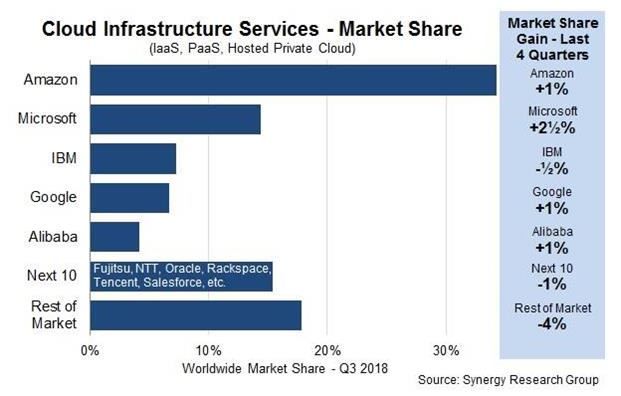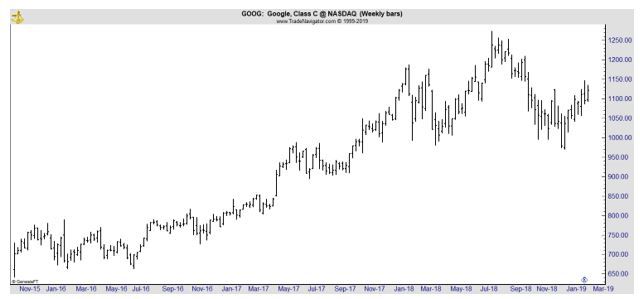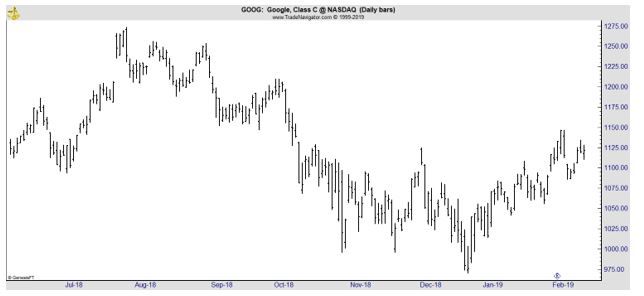TradingTips.com |
| How Google’s $13 Billion Spending Plans Affect the Stock Posted: 21 Feb 2019 09:00 AM PST Google Inc. is planning to spend $13 billion this year on data centers and offices across the U.S., Chief Executive Sundar Pichai recently announced according to The Wall Street Journal. In a blog post, Mr. Pichai said the investments would give Google the capacity to hire tens of thousands of employees and create more than 10,000 new construction jobs in Nebraska, Nevada, Ohio, Texas, Oklahoma, South Carolina and Virginia. The new investments will give Google, a unit of Alphabet Inc., GOOGL -0.85% real-estate assets in 24 states, including data centers in 13 communities, he said. Mr. Pichai said 2019 will mark the second year in a row that Google will grow faster outside the San Francisco Bay Area than in it. The company will develop new data centers in Ohio, Nebraska, Texas, and Nevada. Data center expansions are expected in Oklahoma and South Carolina. It will make significant renewable energy investments, Mr. Pichai said. The company would double its workforce in Virginia and Georgia, and new developments are slated for Washington state, California, Massachusetts, Texas, and Maryland, among other states. Over the past year, Google has made over $9 billion in investments and hired over 10,000 people in the U.S., he said. These are significant investments and they indicate the company has the ability to spend what is needed to maintain a leadership position. Google Plans to Expand Its LeadershipThis capital spending plan is consistent with recent objectives announced by the company. Earlier in the month, "The new leader of Google's cloud-computing business plans to dramatically expand its sales team, addressing one of the biggest challenges he faces as rivals Amazon.com Inc. and Microsoft Corp. race ahead in the market." The Wall Street Journal reported that, "Thomas Kurian said the Alphabet Inc. business had already been ramping up spending on sales and distribution before his arrival. He plans to move faster. "You will see us further accelerate the growth, even faster than we had to date," said Mr. Kurian, who left Oracle Corp. as president of product development in September. He was speaking … at Goldman Sachs & Co.'s technology conference …. While Google has long offered cloud technology, it has seen Amazon and Microsoft surge ahead to become the leaders in providing computing power and storage services for rent over the web. Those companies have robust sales and service staffs that large corporate customers demand to support their technology needs, an area where Google has trailed, analysts have said." This view is confirmed by the chart below which shows market share of industry leaders.
Source: GlobalNewsWire The Journal continued, "Alphabet doesn't break out financial information on Google Cloud. In its most recent quarter, it said other revenues, which include the cloud business, grew 31% to $6.49 billion. Sundar Pichai, chief executive of Alphabet's Google unit, told analysts the cloud unit more than doubled its number of deals valued at more than $1 million and its number of multiyear contracts signed. Even so, Google Cloud is losing ground to Microsoft as the companies chase Amazon in a market that research firm Gartner Inc. estimates hit $32.5 billion last year. Google Cloud's share of the world-wide cloud-infrastructure market grew from 2.7% to 3.3% in 2017, the most recent period Gartner has tallied. At the same time, Microsoft's share grew from 8.7% to 13.3%. Amazon lost share, but still dominated with 51.8% of the market in 2017, down from 53.7% a year earlier. Google needs a team that understands how to engage with large corporate customers, Gartner analyst Lydia Leong said. To catch up, Mr. Kurian is emulating a piece of his former employer's strategy. Oracle built a massive sales staff over decades that holds specific expertise in various industries. At Google, Mr. Kurian said he plans to boost market specialization as well, so sales reps who talk to financial institutions "can talk the language of banking," he said. "We are hiring some of the best talent from around the industry to grow our sales organization, and you will see us competing much more aggressively as we go forward," he said. Google's success has largely come from serving "digital-native" companies—businesses that were born in the internet era and never built their own data centers. Mr. Kurian said he wants to improve Google's ability to address the needs of companies with legacy systems. "A lot of our focus as we go forward is making sure that our sales organization has the background and the ability to sell to large, more traditional companies," Mr. Kurian said. This Could Be Good News For InvestorsInvestors in the company's stock could benefit from an increase in Google's business. The long term chart of the stock shown below shows that the persistent up trend has stalled.
This could be, at least in part, a reaction to the broad trend in the stock market which also topped in October 2018. However, valuation could also be a concern. Analysts expect Google to report earnings per share (EPS) of $47 in 2019 and $about $54.75 in 2020. Looking ahead to 2021, 16 analysts have posted forecasts and the average of those estimates is $64.32. Average growth in EPS is expected to be near 18%. Using a price to earnings (P/E) ratio of 18, the stock could trade at about $1,150 based on 2012 expected earnings. That indicates little potential upside for investors buying at the current level. Of course, an increase in market share in the cloud computing segment could boost earnings beyond expectations. That could drive the stock significantly higher. Short term traders could also consider an opportunity as the stock trades near the upper limit of the recent trading range.
Continued strength in the stock could push prices back to the former highs near $1,275. This would represent a significant short term gain and would be driven by sentiment rather than fundamentals.
|
| You are subscribed to email updates from TradingTips.com. To stop receiving these emails, you may unsubscribe now. | Email delivery powered by Google |
| Google, 1600 Amphitheatre Parkway, Mountain View, CA 94043, United States | |




No comments:
Post a Comment